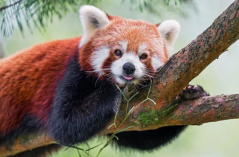
Red pandas are not actually close relatives of the giant panda, belonging to their own unique family. They spend most of their lives in trees, eating, sleeping and sunbathing.
1.1.What can keep red pandas away from enemies to some degree?
A Their long tail.
B Their light weight.
C Their small size.
D Their fur colors.
解析:选D。D 细节理解题。根据第二段最后几句可知,小熊猫红褐色的皮毛与它们生活的环境周围颜色相似,它们还拥有黑色的腹部。这两方面都让天敌很难发现它们。故选D。
2.2.What do the underlined words “tuck into” mean?
A Consume.
B Observe.
C Purchase.
D Control.
解析:选A。A 词义猜测题。根据前文内容“95 per cent of their diet is bamboo.”可知,小熊猫吃很多的竹子,但是除了竹子,它们也“吃”水果、树根、鸡蛋、昆虫和小型哺乳动物。故选A。
3.3.Which sentence can be put back into “ △ ”?
A How do red pandas reproduce?
B What role do the patterns on their fur play?
C How do red pandas climb trees?
D How do red pandas deal with the cold?
解析:选D。D 段落大意题。根据该段内容,尤其是“thick tail”“two layers of fur”“ to cope with night time temperatures of as low as -7 degrees, and also stay dry in snowy conditions”“If temperatures drop really low”可知,该段主要介绍小熊猫如何应对寒冷的天气。故选D。
4.4. What puts red pandas in danger?
A Illegal hunting.
B Climate change.
C Forest development.
D Strong enemies.
解析:选B。B 细节理解题。根据最后一段内容可知,由于森林砍伐、气候危机、森林火灾和为其他动物设置的陷阱,小熊猫的数量越来越少,成为濒危物种。故选B。